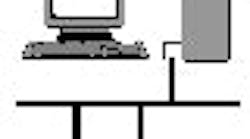FIELDBUS technologies, even simpler ones such as HART, make several orders of magnitude more data available to today’s modern control systems than was possible in the past with traditional analog systems. By “programming” the field device, users could force these systems to fail, either high at 20+ mA or low at 3.8 mA for certain types of faults. Of course, this feature wasn’t always available with Intrinsically Safe installations because of their power limitations, but it could be done in most cases.
Even though we’ve been using HART and fieldbus technologies for more than 10 years, relatively few facilities can use this information. Reasons for this include the fact that, until recently, most HART-based control systems couldn’t use available diagnostic data without adding a parallel system to “strip” the signal off, and forward it to a set of dedicated servers, which didn’t help the situation. Fieldbus systems have been using status information since it’s been available to manage regulatory control loops, sometimes to the chagrin of engineers and operators who weren’t aware of it.
Of course, this only gets data to the enterprise’s control layer, while the real value lies in combining it with business systems to better manage, not just the process, but also scheduled outages, maintenance, batches, and recipes. Yes, you can re-range smart devices to match a new recipe, and market pricing to maximize the return on a facility’s capital assets.
However, to make all this happen requires developing standards to define, not only how the data is to be exchanged across the layers, but also the data’s format and meaning or content. This is the real challenge because now we must work with IT people, such as SAP, Oracle and other Enterprise Resource Planning (ERP) providers, to “create” a common dictionary we all can use to define what each term and data point means.
Do you have to wait until these standards and dictionaries are defined before realizing at least some of the benefits of today’s fieldbus systems? No. Will the integration be harder than you initially guess? Yes, just like most other complex IT projects, the scope is often bigger than originally estimates. However, the prize is great, with some companies reporting a 20% reduction in maintenance costs from getting it right.
Naturally, you can always start small, and simply double your information from the single Process Variable (PV) measurement received today, and use the Status signal for better control by incorporating this information into your control algorithm logic. This will guarantee that you only use valid signals and information to make changes to your process. If the status changes from “Good” to “Uncertain” or “Out of Service,” then you’ll know the device needs maintenance. Also, assuming you don’t yet have an integrated, automated computer maintenance system in place, the operator can then cut the necessary work order, so that at least your technicians are only working on real problems, rather than chasing suspected false readings, as is often the case today.
By using PV and Status information only, you can effectively take a small sip from the fire hose of information available with today’s smart transmitters. Be careful you don’t get soaked! A good way to manage the flow in this fire hose is to develop a team identifying the desired outcomes of your integration project.
First, plan to implement in stages with a little information first to establish the infrastructure is in place and working properly. Next, progress to key diagnostic information for your critical devices, and add more devices. Once you’re comfortable at that level, investigate ways to use this data to predict not only the health of the instrument asset itself, but also the other process equipment to which it’s connected.
As the organization that supports our profession, ISA is as good a place as any to start resolving the above issues, and working with industry to insure that the necessary standards are in place to integrate this information with the higher levels of the enterprise. ISA-95 is a good template to describe the process to be used, and what is needed now. Where ISA has traditionally excelled is in the “how to make it work” piece of the puzzle.
I hope that in the near future, when we are all “information moguls,” that we’ll look back on these times with a hazy fuzziness associated with the “good old days,” when things were simpler, and recall how easy it was to be a “data dummy” but at what a high cost.
| About the Author |




